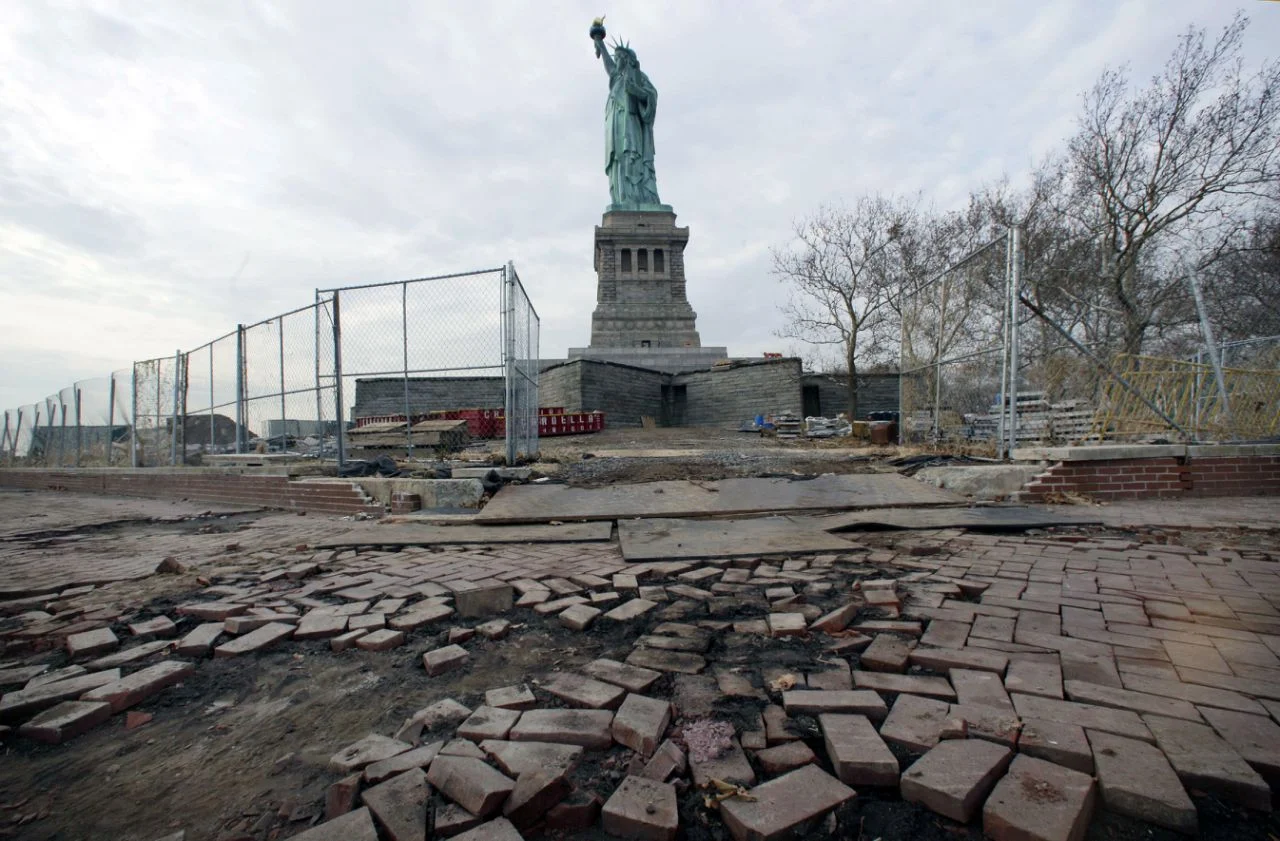
on Liberty Island in New York in 2012. With scientists forecasting sea levels to rise by
anywhere from several inches to several feet by 2100, historic structures and coastal heritage
sites around the world are under threat. A multidisciplinary conference is scheduled to
convene in Newport, R.I., this week to discuss preserving those structures
and neighborhoods that could be threatened by rising seas
[Credit: AP/Richard Drew]
Scientists, historic preservationists, architects and public officials are meeting this week in Newport, Rhode Island—one of the threatened areas—to discuss the problem, how to adapt to rising seas and preserve historic structures.
"Any coastal town that has significant historic properties is going to be facing the challenge of protecting those properties from increased water and storm activity," said Margot Nishimura, of the Newport Restoration Foundation, the nonprofit group hosting the conference.
Federal authorities have encouraged people to elevate structures in low-lying areas, but that poses challenges in dense neighborhoods of centuries-old homes built around central brick chimneys, Nishimura said, especially ones where preservationists are trying to keep the character intact.
Many of the most threatened sites in North America lie along the East Coast between Cape Hatteras, North Carolina, and southern Maine, where the rate of sea level rise is among the fastest in the world, said Adam Markham, of the Union of Concerned Scientists, a speaker at the conference.
"We're actually not going to be able to save everything," he said.
A look at some of the historic areas and cultural sites that are under threat from rising sea levels:
Statue of Liberty and Ellis Island
Situated in New York Harbor, the Statue of Liberty and Ellis Island are some of New York's most important tourist attractions.
In 2012, Superstorm Sandy submerged most of the low-elevation Liberty and Ellis islands. After the storm, the Statue of Liberty, a gift from the people of France in 1886, was closed for eight months. Ellis Island, the entry point for about 12 million immigrants to the United States from 1892 to 1954, remained closed for nearly a year.
A report by the National Park Service looked at how several parks would be threatened by 1 meter, or around 3 feet, of sea level rise. It found $1.51 billion worth of assets at the Statue of Liberty National Monument were highly exposed to sea level rise.
Much of historic Boston is along the water and is at risk due to sea level rise, including Faneuil Hall, the market building known as the "Cradle of Liberty," and parts of the Freedom Trail, a walking trail that links historic sites around the city.
Boston has seen a growing number of flooding events in recent years, up from two annually in the 1970s to an average of 11 annually between 2009 and 2013, according to a 2014 report by the Union of Concerned Scientists. If sea levels rise by 5 inches, the group reported, the number of floods is projected to grow to 31 annually. If seas rise by 11 inches, the number of flooding events is projected to rise to 72 per year.
Newport
The Point neighborhood in the Rhode Island resort town has one of the highest concentrations of Colonial houses in the United States, and it sits 4 feet above mean sea level. Tidal flooding is already occurring in the neighborhood, and that is expected to increase as sea levels rise, Nishimura said. The smell of sea water already permeates the basement of some homes.
Annapolis
Maryland's capital, on Chesapeake Bay, boasts the nation's largest concentration of 18th-century brick buildings. The city briefly served as the nation's capital in the post-Revolutionary War period, and the Treaty of Paris, which formally ended the war, was ratified there. The city is also home to the U.S. Naval Academy.
The city already sees tidal flooding dozens of times a year, and scientists have predicted number could rise to hundreds annually in the next 30 years.
Jamestown
Established in 1607, it is the first permanent English colony in North America. It sits along the tidal James River in Virginia, and most of the settlement is less than 3 feet above sea level. A large part of the settlement has already eroded because of wave action, Markham said. Storms have also damaged the site, including Hurricane Isabel in 2003, which flooded nearly 1 million artifacts. A rising water table at the site also poses a threat to archaeological remains, Markham said.
He called the loss of archaeological artifacts "an urgent problem" along the U.S. coastline.
Hawaii
Reports by the National Park Service and others have found that rising sea level rises threaten archaeological sites at various historic places in Hawaii. Those include ancient fish ponds at Pu'ukohola Heiau National Historic Site and a "Great Wall" at a sacred site in Pu'uhonua o Honaunau National Historical Park. It is considered the best-preserved such wall in Hawaii.
International Sites
Dozens of UNESCO World Heritage Sites are under threat from sea level rise, according to a 2014 report by climate scientists Ben Marzeion, of the University of Innsbruck in Austria, and Anders Levermann, of the Potsdam Institute in Germany.
Among those are: the Tower of London; Robben Island in South Africa, where Nelson Mandela was imprisoned for 27 years; Venice, Italy, and its lagoon; Mont-Saint-Michel, home to an abbey built atop a rocky islet in France; the Kasbah of Algiers, Algeria; the historic district of Old Quebec, Canada; Old Havana in Cuba; and archaeological areas of Pompeii, Italy, and Carthage in Tunisia.
The authors wrote that their findings indicate that "fundamental decisions with regard to mankind's cultural heritage are required."
Author: Michelle R. Smith | Source: The Associated Press [April 11, 2016]